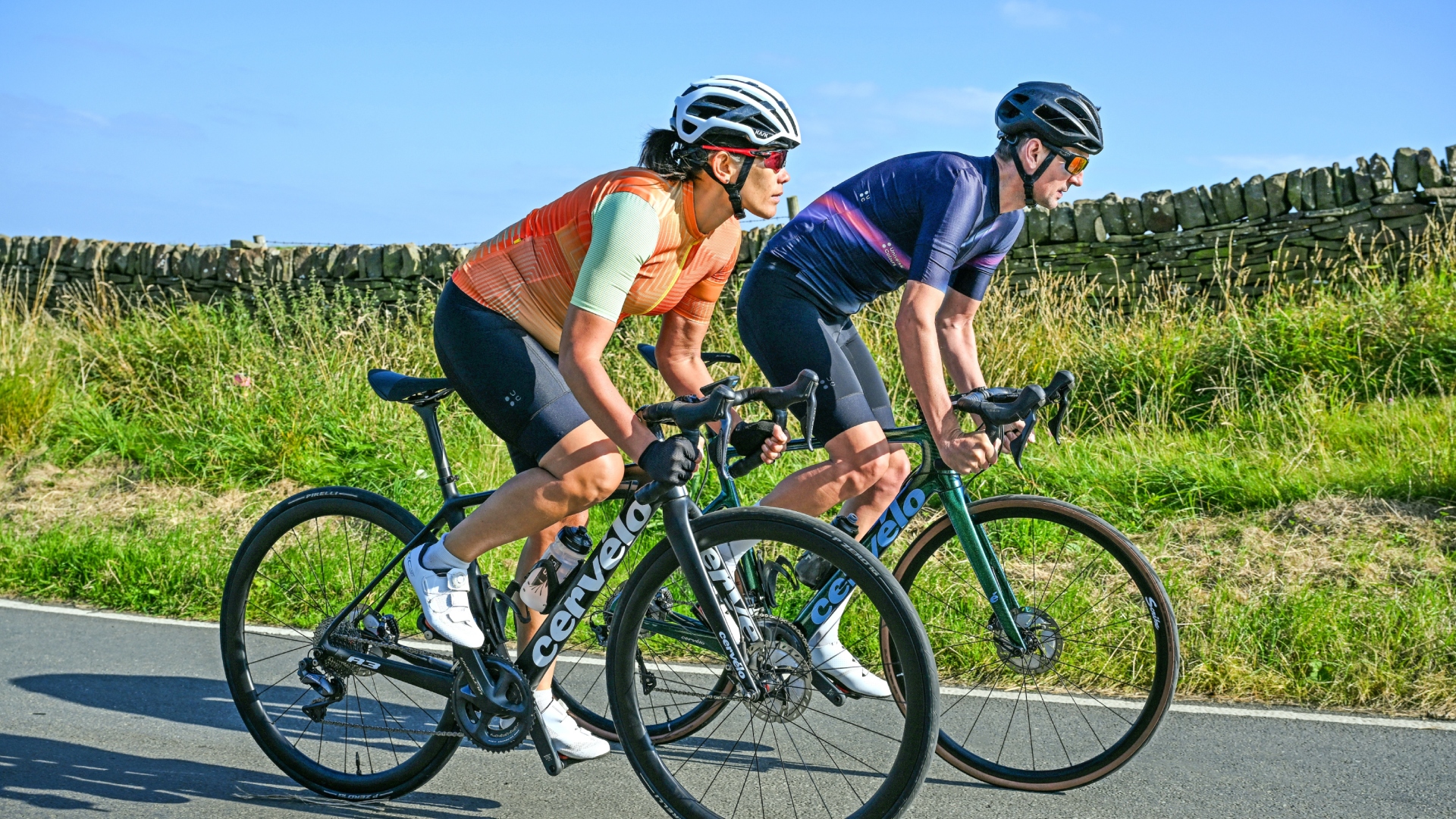Cycling and your pelvic floor: What every rider needs to know
How cycling affects your pelvic floor — and what you can do now to prevent issues down the road


Cycling is an incredible sport with numerous health benefits, but spending long hours in the saddle can take a toll on an often-overlooked part of the body—the pelvic floor. This network of muscles supports the bladder, bowel, and, in women, the uterus, playing a crucial role in core stability and overall function in both men’s and women’s bodies.
Whether you're an elite racer or a casual weekend rider, understanding how cycling affects your pelvic floor is key to preventing discomfort and long-term issues. We spoke with Dr. Krista Jenney, a pelvic floor and women’s health physical therapist at Pelvis Restored, to explore the impact of cycling on these essential muscles and share expert strategies for protection and recovery.
Are cyclists at greater risk of pelvic floor dysfunction?
Cyclists are indeed more susceptible to pelvic floor dysfunction than the general population due to sport-specific factors such as sustained positioning and pressure on the perineum, the area between the genitals and anus.
"The sustained forward flexion and pelvic tilt that occur during long rides can increase tension and tightness in the pelvic floor muscles," explains Dr. Jenney. "Over time, this can lead to pelvic floor dysfunction and discomfort."
Sitting on a bike saddle for long periods can put a lot of pressure on the perineal area, cutting off circulation and possibly irritating nerves or tissue. This can lead to feelings of numbness, discomfort or other pelvic floor issues.
Why should cyclists care if they're symptom-free?
Symptoms of pelvic floor dysfunctions include pain, incontinence, painful intercourse, pelvic pressure and constipation. But just because you’re not feeling any issues now doesn’t mean your pelvic floor doesn’t need attention—ignoring it could lead to performance setbacks and bigger problems down the road.
"Addressing small imbalances early can prevent bigger issues," Dr. Jenney emphasises.
Get The Leadout Newsletter
The latest race content, interviews, features, reviews and expert buying guides, direct to your inbox!
A dysfunctional pelvic floor can negatively impact core stability and force transfer, making cycling less efficient. Additionally, high training volumes and repetitive strain can lead to cumulative wear and tear.
Should pelvic floor care be focused solely on women?
"Absolutely not!" says Dr. Jenney.
It’s true that women—especially elite female athletes—face higher risks due to pregnancy and childbirth, hormonal fluctuations during perimenopause and menopause, and pelvic anatomy. However, men are not exempt from pelvic floor dysfunction.
Male cyclists commonly experience issues such as:
- Sexual Dysfunction and Perineal Pain: Prolonged saddle time can lead to nerve compression and restricted blood flow.
- Urinary Symptoms: Some men may experience hesitancy or dribbling due to pelvic floor dysfunction.
- Core Weakness: A hypertonic and weak pelvic floor can negatively impact power transfer during cycling.
Female cyclists commonly experience:
- Pelvic Pain and Saddle Discomfort: Prolonged time on the saddle and sustained positioning can increase tension and tightness in the pelvic floor muscles and pressure-related pain, numbness, or irritation in the perineal area.
- Urinary and Bowel Dysfunction: Pelvic floor tension or discoordination may contribute to issues like urgency, leakage, or constipation.
- Core and Hip Imbalances: A tight, weak, or uncoordinated pelvic floor can reduce stability, impair power transfer, and increase the risk of hip or lower back pain.
Tips for cyclists to take control of their pelvic health
Dr. Jenney provides key recommendations for maintaining pelvic floor health while cycling:
- Change Positions Regularly: "Alternate hand positions and stand out of the saddle to reduce sustained pressure on the perineum and pelvic floor."
- Bike Fit and Saddle Selection: "Ensure your bike is fitted correctly, and invest in a saddle that supports your anatomy."
- Cross Training: "Incorporate mobility and strength training exercises into your routine to counteract the effects of prolonged cycling posture." Good exercises include lateral lunges, hip abductions and diaphragmatic breathing.
- Monitor Imbalances: "A dual-sided power meter can help identify left/right discrepancies, which could lead to asymmetry and contribute to pelvic dysfunction."
Strategies for preventing and treating pelvic floor discomfort
Weakness in the pelvic floor is best addressed with off-the-bike exercises focused on hip mobility as well as strengthening the core, thighs and scapular. However, the flip side of a weak pelvic floor is one that is overly strong, also referred to as hypertension.
"Overtraining and fatigue can contribute to pelvic floor muscle tension, potentially weakening their strength and coordination," Dr. Jenney warns. When pelvic floor muscles are tense or overactive, the initial focus should be relaxation and flexibility. "It’s essential to restore balance by allowing the muscles to lengthen and relax before progressing to strengthening, as strengthening tight muscles can worsen symptoms."
Pelvic floor dysfunction isn’t just about the pelvis—it’s often linked to other parts of the body. Good breathing habits and managing internal pressure are key to keeping it healthy. Mobility in areas like scar tissue, feet and ankles, hips, ribs, and the spine also plays a big role in how well the pelvic floor functions. Limited mobility in these areas can trigger compensatory movement patterns that result in pelvic floor tension, weakness, or discoordination. Maintaining full-body mobility is, therefore, essential for optimal pelvic health and function.
"These factors, along with others, can significantly impact pelvic floor health," says Dr. Jenney. A pelvic floor physical therapist can provide personalised treatment tailored to each cyclist’s needs.
Seeking professional advice
The pelvic floor is an area that women who have given birth will often be aware of. However, we still live in a culture where it's considered 'normal' to leak urine when running, sneezing or coughing. Thankfully, that narrative is changing, awareness of pelvic floor dysfunction and the physiotherapy available is growing. We spoke to one mom about her experience:
I had an unexpectedly fast vaginal labour with my first child, an experience often considered "lucky". However, a mental image of the comparison between a bowling ball hitting a set of skittles at speed vs a slow trundle down the lane may give some insight into the negative impact of a quick labour. I was made aware by midwives early on that I should begin working on pelvic floor exercises - kegels - soon after birth, and saw a private pelvic floor physiotherapist in the early months. I didn't experience symptoms on the bike or when sneezing/coughing, but running and using a baby carrier were triggers and I was initially advised to focus on relaxation to counter hypertension.
However, adapting to a new life as a working mother meant I didn't devote the attention that recovery really required. It was only two years later, when I was pregnant with my second child, that I sought advice and booked an appointment with an NHS Physiotherapist, learning that all UK women with symptoms are eligible for an appointment after self-referral via their local service. Whilst I was told I was unlikely to see improvements during pregnancy, I've been prioritising the exercises prescribed to me and have seen incremental progress. Plus, I'm now equipped with the knowledge that I'll be eligible for NHS care after delivery and will be referring myself from the earliest opportunity.
Final Thoughts
Dr. Jenney reassures that "the positive health benefits of cycling and exercise outweigh the negatives."
With proactive care, cyclists can enjoy riding for years to come without compromising their well-being. Whether you ride for fun or competition, prioritising pelvic health will keep you strong, comfortable, and ready to hit the road or trail with confidence.

Thank you for reading 20 articles this month* Join now for unlimited access
Enjoy your first month for just £1 / $1 / €1
*Read 5 free articles per month without a subscription

Join now for unlimited access
Try first month for just £1 / $1 / €1

Liz is a freelance writer whose favorite topics include sports, health, and nutrition. She began riding road bikes five years ago and loves to dabble in local criterium races, although she gets the most joy from bike adventures with her friends and family. With a daughter on the way, she's looking forward to setting an example for how women are capable of any endeavor—and how to have fun along the way! Based in Austin, Texas, she also loves rock climbing, making art, and film photography
You must confirm your public display name before commenting
Please logout and then login again, you will then be prompted to enter your display name.
-
 'I'll take a top 10, that's alright in the end' - Fred Wright finishes best of British at Paris-Roubaix
'I'll take a top 10, that's alright in the end' - Fred Wright finishes best of British at Paris-RoubaixBahrain-Victorious rider came back from a mechanical on the Arenberg to place ninth
By Adam Becket Published
-
 'This is the furthest ride I've actually ever done' - Matthew Brennan lights up Paris-Roubaix at 19 years old
'This is the furthest ride I've actually ever done' - Matthew Brennan lights up Paris-Roubaix at 19 years oldThe day's youngest rider reflects on 'killer' Monument debut
By Tom Davidson Published